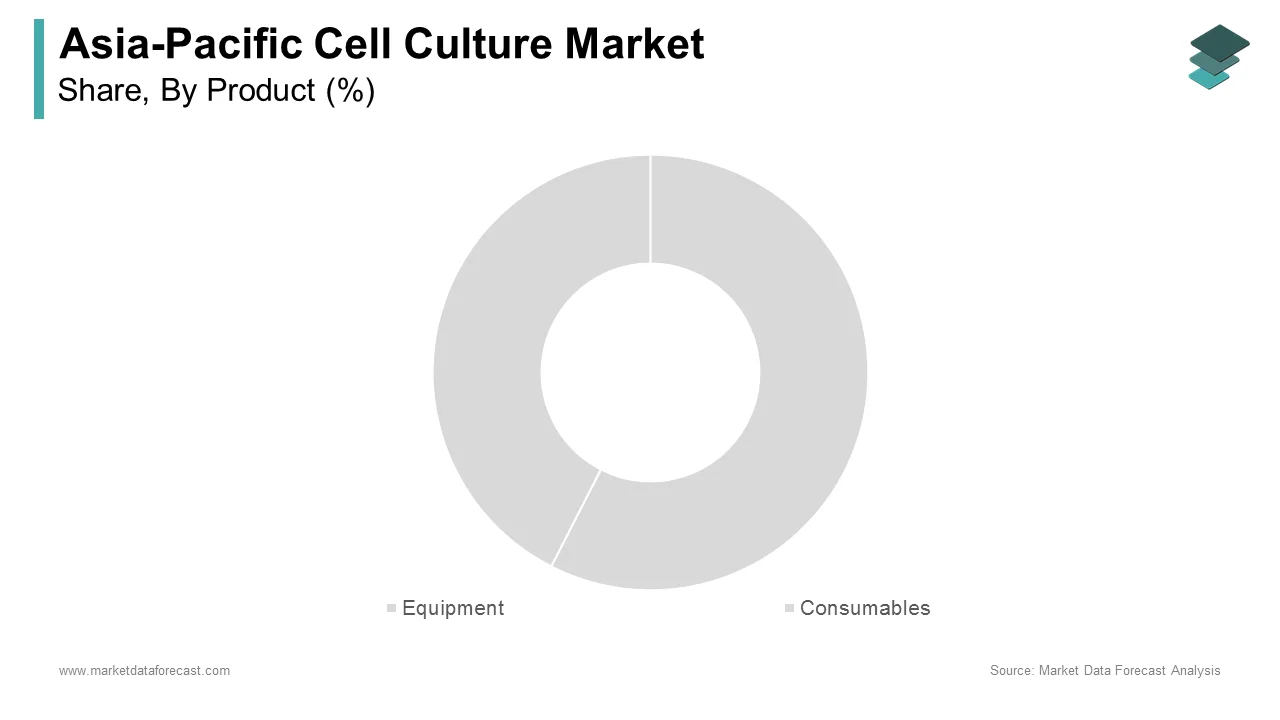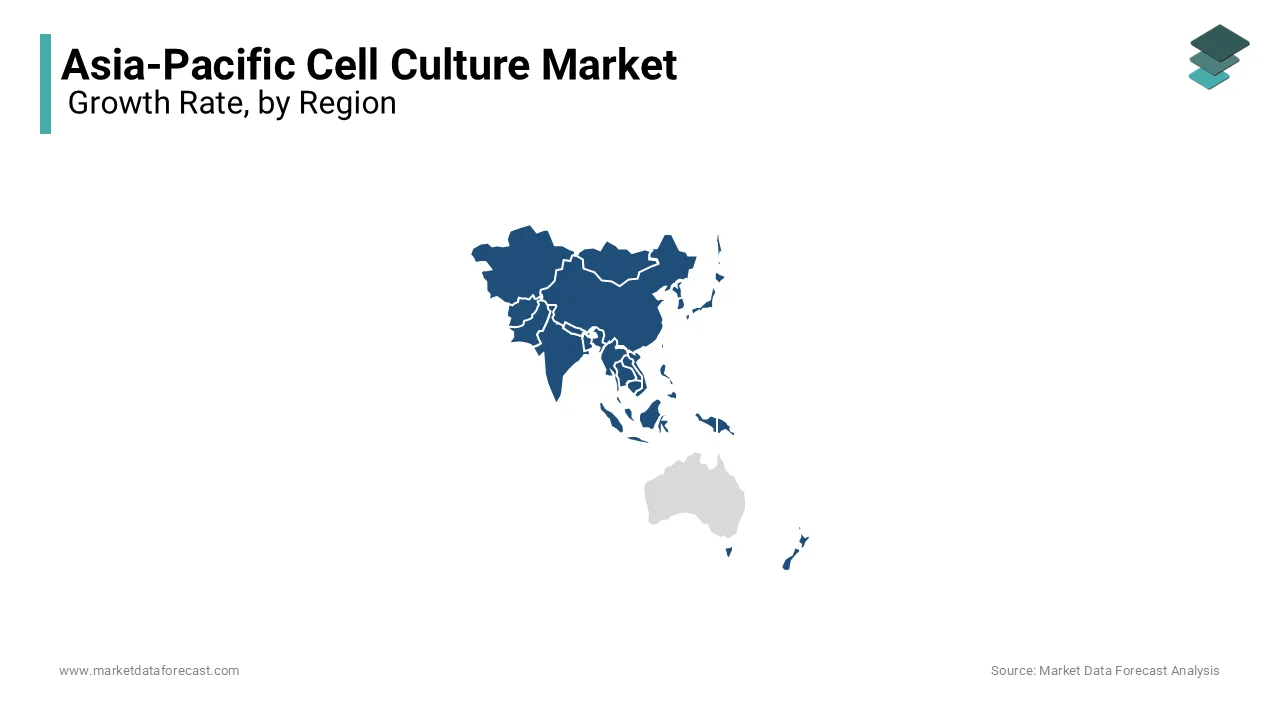Asia-Pacific Cell Culture Market Size, Share, Trends & Growth Forecast Report By Product, Application, End User and Country (India, China, Japan, South Korea, Australia, New Zealand, Thailand, Malaysia, Vietnam, Philippines, Indonesia, Singapore and Rest of Asia-Pacific), Industry Analysis From 2025 To 2033
Asia-Pacific Cell Culture Market Size
The size of the cell culture market in the Asia Pacific was worth USD 5 billion in 2024. The Asia-Pacific market is estimated to be growing at a CAGR of 12.12% from 2025 to 2033 and be worth USD 14 billion by 2033 from USD 5.6 billion in 2025.

Cell culture focuses on the cultivation and maintenance of cells under controlled laboratory conditions and enables significant advancements in medical and scientific research. Cell culture serves as a cornerstone for applications such as drug development, vaccine production, tissue engineering, and the study of cellular behaviors. The rising demand for cell-based therapies, regenerative medicine, and biopharmaceutical production has accelerated the adoption of cell culture methodologies across the Asia-Pacific region. Notably, China and Japan are at the forefront of advancements in this field, owing to their investments in biotechnology and the establishment of cutting-edge research facilities. According to the World Health Organization, the Asia-Pacific region has seen a substantial increase in vaccine production, partly facilitated by advancements in cell culture technologies.
MARKET DRIVERS
Growing Demand for Biopharmaceuticals in Asia-Pacific
The increasing demand for biopharmaceuticals, including monoclonal antibodies, vaccines, and recombinant proteins, is a key driver of the Asia-Pacific cell culture market. The World Health Organization emphasizes the role of biologics in treating chronic diseases such as cancer and autoimmune disorders, which are on the rise in the region. For instance, the International Agency for Research on Cancer reported that Asia accounted for approximately 49.3% of global cancer cases in 2020, creating a surge in demand for targeted biologic therapies. Cell culture technologies are integral to producing these therapeutics, fostering their adoption by biotechnology firms across countries like China and India, where government policies promote the local manufacturing of biopharmaceuticals.
Advancements in Vaccine Development
Advancements in vaccine development, accelerated by the COVID-19 pandemic, have significantly boosted the adoption of cell culture technologies. The Asia-Pacific region has emerged as a hub for vaccine production, with India and China leading global manufacturing efforts. According to the World Health Organization, these nations collectively produce more than 60% of the world's vaccines, relying heavily on cell culture methods for production. Additionally, the growing prevalence of infectious diseases such as dengue and influenza has further fueled investments in vaccine R&D. Cell culture enables scalable and efficient vaccine production, ensuring rapid response to health crises and contributing to improved public health outcomes in the region.
MARKET RESTRAINTS
High Costs of Cell Culture Technologies in Asia-Pacific
The elevated cost of cell culture technologies is a significant restraint for the Asia-Pacific market. Setting up advanced cell culture facilities involves substantial capital investment in equipment, such as bioreactors and automated cell culture systems, which can cost millions of dollars. According to the Asia-Pacific Economic Cooperation (APEC), smaller research institutions and biotechnology startups often struggle to afford such technologies, limiting their ability to compete. Furthermore, the recurring expenses for high-grade consumables, such as media and growth factors, add to operational costs, making it challenging for underfunded organizations to sustain operations. This financial barrier slows the adoption of cell culture technologies, particularly in developing countries within the region.
Limited Skilled Workforce in Asia-Pacific
A shortage of trained professionals proficient in cell culture techniques poses another restraint for the market. The Asia-Pacific Centre for Technology Transfer has highlighted a significant skills gap in biotechnology, noting that many countries lack adequate training programs to meet the growing demand for specialized personnel. This limitation is particularly pronounced in emerging economies such as Vietnam and the Philippines, where higher education and professional development opportunities in life sciences are less accessible. The lack of skilled staff hampers research productivity and increases the likelihood of errors in cell culture processes, delaying advancements in biopharmaceutical production and other applications critical to the region’s healthcare system.
MARKET OPPORTUNITIES
Expansion of Regenerative Medicine in Asia-Pacific
The growing focus on regenerative medicine presents a significant opportunity for the Asia-Pacific cell culture market. Regenerative therapies, including stem cell treatments and tissue engineering, rely heavily on cell culture technologies for the growth and differentiation of cells. The World Health Organization highlights that Asia-Pacific has one of the fastest-aging populations globally, with Japan reporting over 28% of its population aged 65 and older in 2022. This demographic shift has driven demand for treatments targeting age-related conditions such as osteoarthritis and cardiovascular diseases. Governments in countries like South Korea and Japan are funding stem cell research, fostering advancements in cell culture techniques, and creating a favorable environment for market growth in regenerative medicine.
Increasing Investments in Biotechnology Infrastructure
Rising investments in biotechnology infrastructure across Asia-Pacific provide substantial growth opportunities for the cell culture market. China and India, in particular, have prioritized biotechnology as a strategic sector, with China allocating over $70 billion to life sciences and biotechnology initiatives between 2021 and 2025, according to the Ministry of Science and Technology of China. These investments enhance research capabilities and establish advanced cell culture facilities. Moreover, India’s Biotechnology Industry Research Assistance Council supports the development of biopharmaceuticals and vaccines, creating a robust demand for cell culture products. This regional emphasis on building state-of-the-art facilities is expected to accelerate innovation and drive the adoption of cell culture technologies across various applications.
MARKET CHALLENGES
Regulatory Complexity and Variability
The diverse regulatory landscape across Asia-Pacific poses a significant challenge to the cell culture market. Countries in the region implement varying standards for biopharmaceutical production, research approvals, and cell therapy applications. For instance, the National Medical Products Administration in China mandates stringent protocols for clinical trials involving cell-based therapies, which can lead to prolonged approval timelines. Similarly, India's Central Drugs Standard Control Organization has different guidelines, complicating cross-border collaborations. According to the Asia-Pacific Economic Cooperation, these regulatory inconsistencies hinder market growth by creating operational inefficiencies and increasing compliance costs, particularly for multinational companies operating across multiple jurisdictions.
Infrastructure Gaps in Emerging Markets
Emerging economies in the Asia-Pacific region often face challenges due to inadequate biotechnology infrastructure. Countries such as Vietnam and the Philippines lack sufficient access to advanced laboratories and cell culture facilities, limiting their capacity to support research and biopharmaceutical production. The United Nations Economic and Social Commission for Asia and the Pacific (UNESCAP) reports that underdeveloped scientific infrastructure slows the adoption of cutting-edge technologies in these regions. Additionally, the uneven distribution of resources, including high-quality reagents and specialized equipment, exacerbates the disparity between developed and emerging markets. These challenges restrict regional growth, preventing emerging economies from fully participating in the expanding cell culture market.
SEGMENT ANALYSIS
By Product Insights

REGIONAL ANALYSIS
China captured the leading share of the Asia-Pacific cell culture market in 2024. China is a dominant player in the Asia-Pacific cell culture market owing to its massive investments in biotechnology. The Ministry of Science and Technology of China allocated over $70 billion to life sciences research between 2021 and 2025, fostering advancements in cell culture techniques. Additionally, China accounts for a significant share of global vaccine production, manufacturing over 5 billion doses annually, as noted by the World Health Organization. The country’s robust pharmaceutical industry and focus on regenerative medicine have made it a hub for biopharmaceutical development, positioning China as a leader in cell culture applications for drug discovery and vaccine production.

Japan is another notable regional segment for cell culture in Asia-Pacific. The promising role of Japan in the Asia-pacific market is majorly attributed to its advanced research infrastructure and emphasis on regenerative medicine. According to the Ministry of Health, Labour, and Welfare, Japan has been a pioneer in stem cell research, particularly induced pluripotent stem cells (iPSCs), which are critical for tissue engineering and cell therapy. The country’s aging population, with over 28% aged 65 and older in 2022, has driven demand for innovative treatments for age-related diseases. This focus on regenerative medicine, combined with government-backed research initiatives, has solidified Japan’s position as a leader in cell culture technologies in the region.
India has emerged as a significant player in the Asia-Pacific cell culture market due to its expanding biopharmaceutical sector and cost-effective manufacturing capabilities. The Biotechnology Industry Research Assistance Council supports the development of vaccines and biosimilars, fostering demand for cell culture products. India is one of the largest vaccine producers globally, accounting for 60% of the world’s vaccine supply, as stated by the World Health Organization. This strong foundation in vaccine production, coupled with rising investments in biotechnology infrastructure, has positioned India as a leading market for cell culture applications in the region.
KEY MARKET PLAYERS
Some of the notable companies leading the ASIA-PACIFIC cell culture market profiled in the report are Thermo Fisher Scientific, GE Healthcare, Merck KGaA, Sartorius AG, Eppendorf AG, Lonza AG, Corning, Becton, Dickinson and Company, Promocell GmbH, and Hi-Media Laboratories.
MARKET SEGMENTATION
This research report on the Asia-Pacific cell culture market has been segmented and sub-segmented into the following categories.
By Product
- Equipment
- Bioreactors
- Cell Culture Vessels
- Cell Culture Storage Equipment
- Cell Culture Supporting Equipment
- Consumables
- Sera, Media & Reagents
- Bioreactor Accessories
By Application
- Biopharmaceutical
- Vaccine Production
- Diagnostics
- Recombinant Therapeutic Proteins
- Cancer Research
- Stem Cell Technologies
- Drug Screening and Development
- Tissue Engineering & Regenerative Medicine
- Other Applications
By End-User
- Pharmaceutical and Biotechnology Companies
- Research Institutes
By Country
- India
- China
- Japan
- South Korea
- Australia
- New Zealand
- Thailand
- Malaysia
- Vietnam
- Philippines
- Indonesia
- Singapore
- Rest of Asia-Pacific
Related Reports
Access the study in MULTIPLE FORMATS
Purchase options starting from
$ 2000
Didn’t find what you’re looking for?
TALK TO OUR ANALYST TEAM
Need something within your budget?
NO WORRIES! WE GOT YOU COVERED!
Call us on: +1 888 702 9696 (U.S Toll Free)
Write to us: sales@marketdataforecast.com
